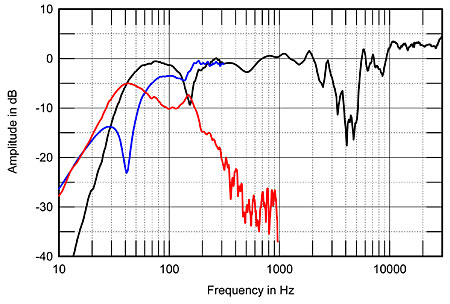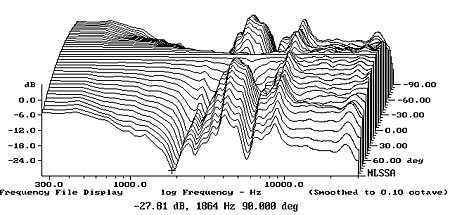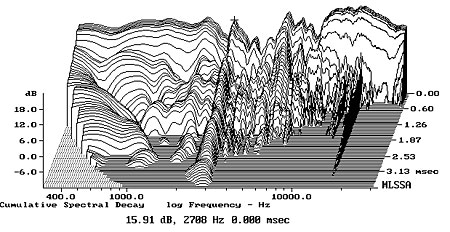| Columns Retired Columns & Blogs |
That frequency response plot shows a massive suckout, dipping to -17 dB at centered right at the ear's most sensitve area. What does it take to get a bad review in Stereophile these days?
One of the Zu Essence's unique selling points is its very high efficiency. While my estimate of its sensitivity, 92.5dB(B)/2.83V/m, is lower than the specified 97dB (due, I suspect, both to the 12 ohm impedance and to the lack of presence-region energy in the on-axis response—see later), it's still 10dB higher than the sensitivity of the BBC LS3/5A. Probably to oversimplify, the Zu speaker driven by 10W will play as loudly as the LS3/5A driven by 100W—assuming the little BBC monitor could actually handle 100W without melting!
Not only does the Essence not require many volts to play loud, it doesn't need many amps, either: its impedance magnitude (fig.1, solid trace) remains above 12 ohms for most of the bass and treble, with a minimum value of 8.6 ohms at 250Hz. However, in the top octave—the region covered by its ribbon supertweeter—the impedance drops below 8 ohms to reach a value of just 4.3 ohms at 20kHz. With tube amplifiers having the usual high source impedance, the disparity between the impedance in the mid-treble and that above 10kHz will shelve the top octave down. Similarly, the reduced impedance in the lower midrange compared with that in the bass and treble will suppress that region somewhat when the Essence is driven by a tube amplifier.

Fig.1 Zu Essence, electrical impedance (solid) and phase (dashed). (5 ohms/vertical div.)
The small impedance peak at 150Hz and the discontinuity in the magnitude trace just above 400Hz imply the existence of enclosure resonances of some kind. The Essence's large cabinet panels don't appear to be damped in any way, and investigating their vibrational behavior with an accelerometer uncovered the existence of many high-amplitude resonances (fig.2). While there is a mode at 150Hz, the highest-level modes occur at 290, 390, and 490Hz, with the specific mix of modes differing according to which panel was being tested and where on that panel I had placed the accelerometer. What was odd, however, was that when I listened to the cabinet walls with a stethoscope while playing the semitone-spaced stepped toneburst track from Editor's Choice (CD, Stereophile STPH016-2), while I could hear the resonances, they were not as obtrusive-sounding on music as their measured behavior had led me to expect.

Fig.2 Zu Essence, cumulative spectral-decay plot calculated from output of accelerometer fastened to center of front baffle (MLS driving voltage to speaker, 7.55V; measurement bandwidth, 2kHz).
The Zu's cabinet resonances are all of very high Q, or Quality Factor, and the rule of thumb is that for a resonance to be fully excited, it needs to be stimulated by a sustained tone at its center frequency for the same number of cycles as the Q; ie, if there is a resonance at 400Hz with a Q of 100, it will take 100 cycles—a quarter of a second—for the resonance to fully ring. If the stimulus doesn't last that long or is not quite at the same frequency, the resonance will not fully develop. That will not be true for impulsive signals, however, so while it's possible that the Zu Essence's cabinet resonances will not color the sound with sustained tones, they will add coloration to drum recordings. I could also hear the cabinet-induced coloration on male spoken voice, which, of course, is not confined to the fixed pitches of the Western Scale. As Art Dudley explains, the Essence's bass loading is intriguing, resembling a quarterwave horn, but with a foam wedge progressively loading the vent at the opposite end of the enclosure from the drive-unit. However, the twin low-frequency peaks in the speaker's impedance suggest that the woofer alignment is more akin to that of a reflex design, with the port tuned to 41Hz. While I was visiting AD, to measure the speakers in his listening room (see later), I measured the woofer's nearfield response with and without the internal foam wedge in place, making sure in the latter case that the vent opening was the same size as it had been with the wedge. The amplifier used was Art's Shindo Haut-Brion, whose transformer has a 16 ohm secondary winding.
The results are shown in fig.3. The red trace was taken with the wedge in place. The curve looks similar to that of a reflex-loaded woofer with its port tuned to 43Hz, there being the usual minimum-motion notch at that frequency. (This is when the back pressure from the port resonance holds the woofer cone still.) There is another suckout in the woofer's output between 100 and 170Hz. Without the wedge (blue trace), the vent tuning frequency moves 10Hz higher in frequency, and the peaks and dips are a little more extreme. The foam thus appears to lower the frequency of the vent tuning and lower the overall Q. Looking at the step responses of the woofer and vent (fig.4), the fact that the woofer output (blue) and that of the vent (red) are in opposite polarity does suggest that the Essence's bass alignment is closer to that of a reflex design than a true horn.

Fig.3 Zu Essence, anechoic response on woofer axis at 10", with internal foam wedge in place (red) and with cabinet empty (blue).

Fig.4 Zu Essence, step response of woofer (blue) and vent (red). (50ms time window, 1kHz bandwidth)
This is confirmed by looking at fig.5, which shows the nearfield responses of the woofer (blue) and vent (red). The woofer's output again features a well-defined minimum-motion point, while the vent's output peaks at the same frequency. However, placing the vent at the end of the pipe introduces a second peak in the vent's output, at 150Hz—not coincidentally, the frequency of the impedance peak noted earlier and of a step down in the woofer's output. The black trace below 300Hz in fig.5 shows the complex sum of the woofer and vent outputs, taking into account acoustic phase and the different distances of the radiators from a nominal farfield microphone position. The upper vent resonance gives rise to a sharp notch in the combined output. The usual boost in the upper bass that results from the nearfield measurement technique is absent, suggesting that the Essence's bass extension will not be as great as might be expected from the large size of the enclosure. The bass will also be tightly controlled.

Fig.5 Zu Essence, anechoic response on tweeter axis at 50", averaged across 30° horizontal window and corrected for microphone response, with nearfield woofer (blue) and vent (red) responses plotted below 300Hz and 1kHz, respectively, plus complex sum of nearfield responses (black).
The Zu speaker's midrange response, taken on the supertweeter axis, is basically flat and even, but even with the whizzer cone, the drive-unit is in breakup at and above 2kHz, with a large suckout evident in the presence region. (This suckout reduces the measured sensitivity, as indicated earlier.) The response is reinforced by the ribbon supertweeter in the top two octaves, and the ribbon unit is 3dB too high in level on this axis, which is 34" from the ground. The average height of a seated listener's ears, we have found, is 36" from the ground, but Art Dudley sits about 6" higher than that. Fig.6 shows the Essence's vertical dispersion, normalized to the ribbon-unit axis; it appears that the presence-region suckout does fill in a little on the woofer axis.

Fig.6 Zu Essence, vertical response family at 50", normalized to response on tweeter axis, from back to front: differences in response 15–5° above axis, reference response, differences in response 5–10° below axis.
The Zu's lateral-dispersion plot (fig.7) indicates that the suckout also fills in to the speaker's sides. The speaker's treble balance can thus be optimized by experimenting with both listener height and toe-in angle. Art had the speakers set up so that their axes crossed behind his listening position, and their spatially averaged response in his room, driven by the tubed Shindo amplifier, is shown as the red trace in fig.8. (I derive this graph by averaging 20 measurements taken for each speaker in a rectangular grid measuring 36" by 18" and centered on the position of the listener's ears. I used an Earthworks omni microphone and a Metric Halo ULN-2 FireWire audio interface, in conjunction with SMUGSoftware's Fuzzmeasure 2.0 running on my Apple laptop.) The peaks and dips below 300Hz are room effects that have not been minimized by the spatial averaging. However, the gentle slope down from 700 to 120Hz appears to be real, and I wonder if this led to Art's finding that the Essence slightly lacked midrange clarity and resolution (though the cabinet resonances may well have added to this impression).

Fig.7 Zu Essence, lateral response family at 50", normalized to response on tweeter axis, from back to front: differences in response 90–5° off axis, reference response, differences in response 5–90° off axis.
The blue trace in fig.8 shows the Essences' spatially averaged response taken in my listening room, the speakers toed-in to the listening position and driven by a solid-state amplifier. The speakers actually work better at low frequencies in my room than in Art's. In general, the overall shapes of the two traces map very closely between 150Hz and 5kHz, though the tube amp's higher output impedance gives rise to a little more low-treble energy in Art's room. The traces are very different above 5kHz, Art's use of the tube amp and his using less toe-in giving rise to a smoothly sloped-down response in the top two audio octaves. I could hear this as a lack of "air" when I auditioned the Essences in Art's room, though he doesn't mention it in his own listening comments. In my room, with the speakers toed-in to the listening seat and driven by a solid-state amp, there was way too much top-octave energy, both in the spatially averaged response and in the tonal balance.

Fig.8 Zu Essence, spatially averaged, 1/6-octave response in AD's listening room, driven by Shindo tube amp (red); spatially averaged, 1/6-octave response in JA's listening room, driven by Simaudio solid-state amp (blue).
In the time domain, the Essence's step response on the supertweeter axis is shown in fig.9. Both drive-units are connected in positive acoustic polarity, and the ribbon unit's output (the sharp up-down-up spike) slightly leads that of the woofer (the right-triangle shape). Moving a little higher will bring the two units' outputs into time alignment.

Fig.9 Zu Essence, step response on tweeter axis at 50" (5ms time window, 30kHz bandwidth).
The cumulative spectral-decay plot on this axis (fig.10) is relatively clean in the midrange and in the top octave, but looks terrible in the mid-treble, with significant ridges of delayed energy evident at 1865Hz, 2.7kHz, and 5.8kHz, as well as some lower-level hash at other frequencies. Like the plots of lateral and vertical dispersion, this graph suggests that the Essence's owner will need to experiment with toe-in and listening height to mitigate the effect of these cone-breakup modes by reducing the energy level in the same region.

Fig.10 Zu Essence, cumulative spectral-decay plot on tweeter axis at 50" (0.15ms risetime).
In many ways, the Zu Essence is an underachiever, measurement-wise. But the surprise for me, when I auditioned it in AD's room, was how much of its measured misbehavior was not too audible, other than the rolled-off highs and the lack of impact in the lower midrange. I suspect that Zu's designer has carefully balanced the individual aspects of the Essence's design so that the musical result is greater than the sum of its often disappointingly-measuring parts.—John Atkinson

That frequency response plot shows a massive suckout, dipping to -17 dB at centered right at the ear's most sensitve area. What does it take to get a bad review in Stereophile these days?